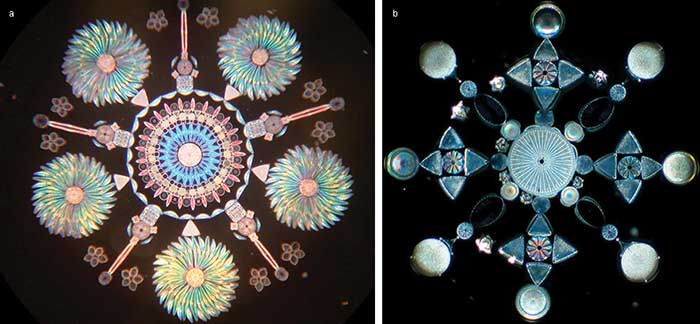Design at the intersection of light and nature leads to discoveries that benefit biomedical applications.
 Nothing compares with nature’s ability to design complex biological organisms and structures, refined by eons of evolution. Natural design has inspired scientists for centuries to try to imitate natural phenomena such as the sticky grip of a gecko, the camouflage of an octopus or the flight of a bird. Similarly, bio-inspired photonics extracts inspiration from the way organisms interact with light, applying it to photonics technology and manmade systems, perhaps using different materials, architectures or configurations.
In the early 1800s, the invention of the microscope inspired professionals and interested members of the public to purchase the tool to explore the diverse beauty of the microscopic world. As exploring aspects of the microcosm grew into a fad, the demand increased for slides mounted with tiny objects. One of the first minute targets depicted in mounted slides were beautiful arrangements of marine diatoms — the silicon exoskeletons of single-celled algae (Figure 1).
“Diatoms do an amazing thing,” said Robert Norwood, professor of optical sciences at the University of Arizona, Tucson. “They create frustules — exoskeletons out of fused silica like that in optical fiber.”
The miniature, three-dimensional glass shells are elaborate and highly variable in shape: criss-crossing bars, barrels, stars, triangles, saucers. Inspired by complex arrangements of hundreds of thousands of shapes of frustules from hundreds of thousands of species of diatoms, Norwood and his colleagues started manipulating diatoms and growing them, building on previous work that used them as lenses because of their periodic structure and curved nature.
They found that by directing a broadband (400- to 1700-nm) supercontinuum laser focused to a 20-µm-diameter spot through the central valve of a frustule no bigger than 100 µm, the light is diffracted1. Furthermore, as they changed the angle of incidence of the beam, they found that the photonic bandgap wavelengths are directly correlated to the periodicity of the pore pattern in the valve. In other words, the diatom acted like a tunable filter (Figure 2).
“The interesting follow-on is that this is reproducible via genetic engineering,” Norwood said. “We can grow a micro- or nano-device tailored with a periodic pore structure like that of multiple species of diatom frustules to fit the needs of various applications.”
When working with optical biosensors, for example, the frustules can be chemically modified to bind to a specific bioprobe that can work as an antibody. These modified diatom frustules emit photoluminescence that reveal how much interaction occurs between antibody and ligand, a molecule that binds to another (usually larger) molecule. They can also be useful in lab-on-a-chip applications.
“We’ve now found a way to make diatoms be a true photonic crystal,” Norwood said.
Nothing compares with nature’s ability to design complex biological organisms and structures, refined by eons of evolution. Natural design has inspired scientists for centuries to try to imitate natural phenomena such as the sticky grip of a gecko, the camouflage of an octopus or the flight of a bird. Similarly, bio-inspired photonics extracts inspiration from the way organisms interact with light, applying it to photonics technology and manmade systems, perhaps using different materials, architectures or configurations.
In the early 1800s, the invention of the microscope inspired professionals and interested members of the public to purchase the tool to explore the diverse beauty of the microscopic world. As exploring aspects of the microcosm grew into a fad, the demand increased for slides mounted with tiny objects. One of the first minute targets depicted in mounted slides were beautiful arrangements of marine diatoms — the silicon exoskeletons of single-celled algae (Figure 1).
“Diatoms do an amazing thing,” said Robert Norwood, professor of optical sciences at the University of Arizona, Tucson. “They create frustules — exoskeletons out of fused silica like that in optical fiber.”
The miniature, three-dimensional glass shells are elaborate and highly variable in shape: criss-crossing bars, barrels, stars, triangles, saucers. Inspired by complex arrangements of hundreds of thousands of shapes of frustules from hundreds of thousands of species of diatoms, Norwood and his colleagues started manipulating diatoms and growing them, building on previous work that used them as lenses because of their periodic structure and curved nature.
They found that by directing a broadband (400- to 1700-nm) supercontinuum laser focused to a 20-µm-diameter spot through the central valve of a frustule no bigger than 100 µm, the light is diffracted1. Furthermore, as they changed the angle of incidence of the beam, they found that the photonic bandgap wavelengths are directly correlated to the periodicity of the pore pattern in the valve. In other words, the diatom acted like a tunable filter (Figure 2).
“The interesting follow-on is that this is reproducible via genetic engineering,” Norwood said. “We can grow a micro- or nano-device tailored with a periodic pore structure like that of multiple species of diatom frustules to fit the needs of various applications.”
When working with optical biosensors, for example, the frustules can be chemically modified to bind to a specific bioprobe that can work as an antibody. These modified diatom frustules emit photoluminescence that reveal how much interaction occurs between antibody and ligand, a molecule that binds to another (usually larger) molecule. They can also be useful in lab-on-a-chip applications.
“We’ve now found a way to make diatoms be a true photonic crystal,” Norwood said.
Member Exclusive: To read the complete article, please Login or Register